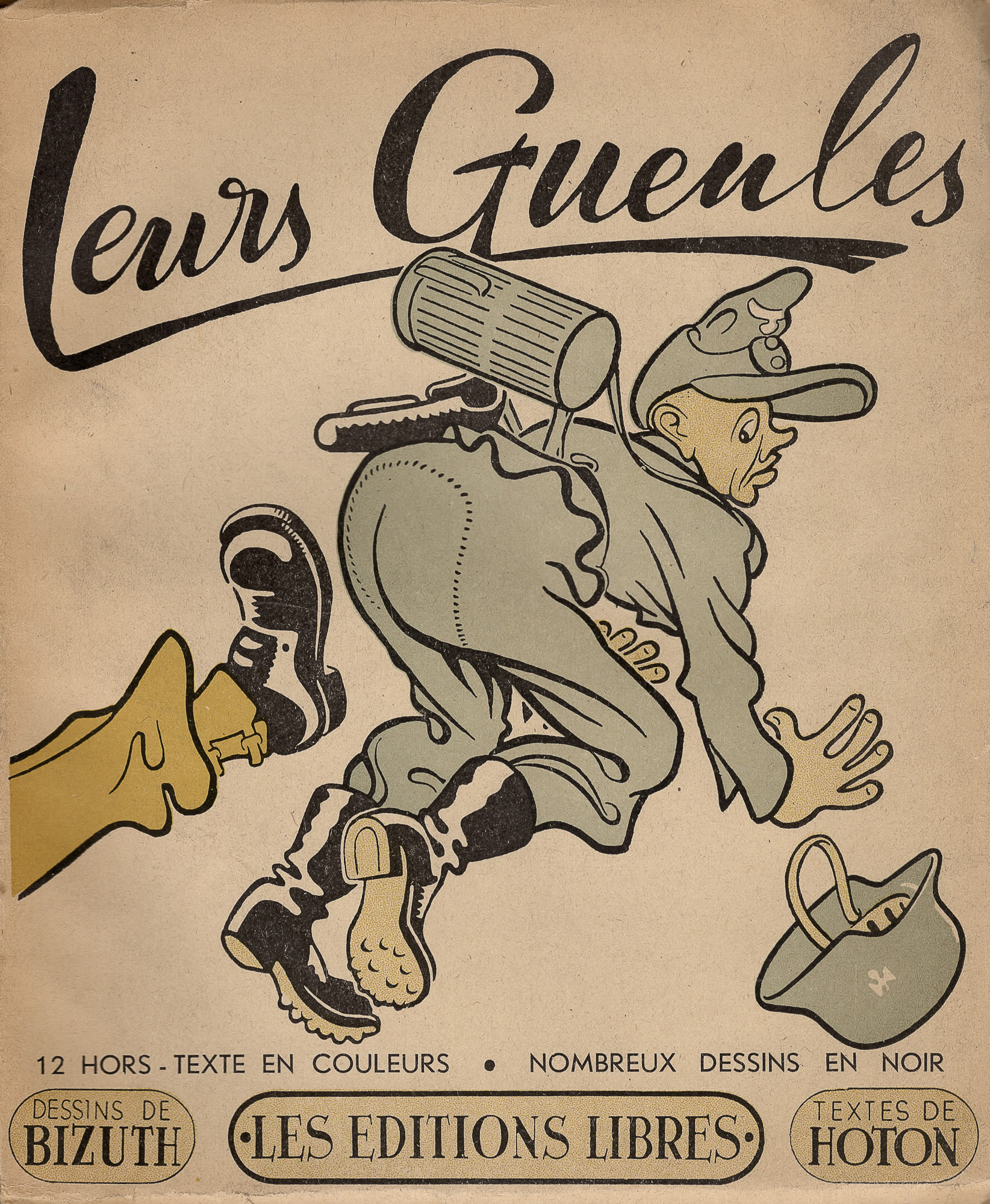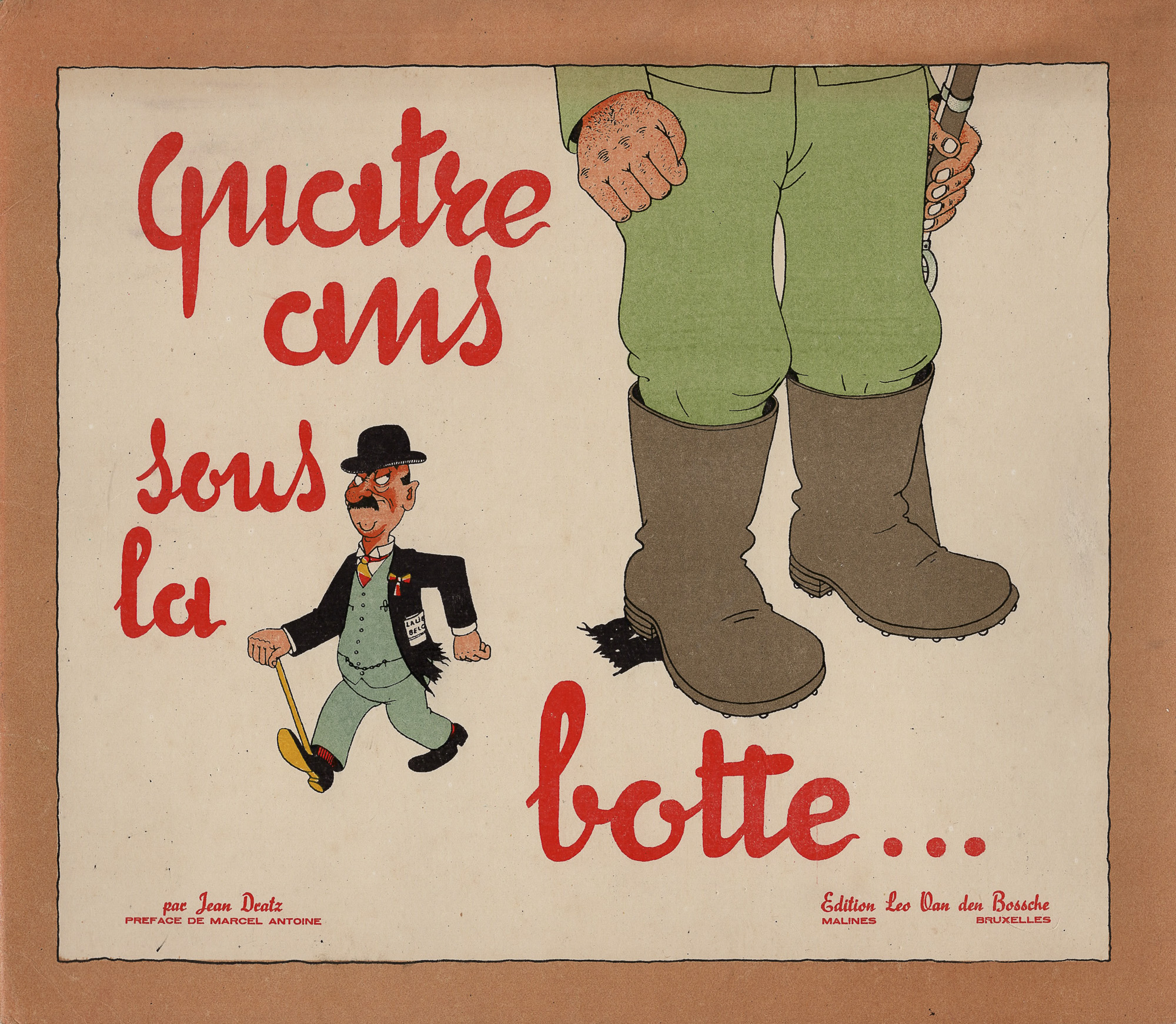In 2019, I started working on a project aimed at providing access through Cambridge University Library catalogue (iDiscover) to digitised images of book covers of the Chadwyck-Healey collection (about 3000 books in French about the Second World War, the Occupation and the Liberation, published between 1944 and 1946), with photographer Fanny Bara. We were struck by the number of titles and cover illustrations featuring the German boot (see my previous blog post on the use of the expression “sous la botte” in the literature of the Liberation). More than half of the Liberation collection books whose title refers to the German boot feature illustrated covers including an actual depiction of a boot (five covers) or German soldiers in uniform (six covers, three of which are photographic). Only the comic book Biroulet sous la botte by Raymond Sempé, (Liberation.a.37) features a strictly black and white cover illustration: while a stern looking German soldier goose steps, Biroulet, depicted as a mischievous peasant child, wearing clogs and beret, and holding a simple wooden stick, cocks a snook at him.

Youthful irreverence towards the German enemy also appears on the blue cover illustration of Gavroche sous la botte (Liberation.c.304), where a teenager daringly kicks the bottom of a German officer. A similar scene appears on the cover of another humouristic publication, Leurs gueules: essai de zoologie germanique by Edmond Hoton, illustrated by Bizuth (Hubert Olyff), published in Brussels in 1944 (Liberation.b.196). In this case, the focus is on the German soldier falling to the ground, while the identity of his attacker remains hidden; only the culprit foot is framed in the illustration.


The combination of the French national colours appears throughout the book covers of the Liberation collection. In En Ardenne sous la ‘botte’ by Francis Paulet (Liberation.c.431), the title, printed in black, expressing the subjugation of Ardennes by the Germans, seems visually challenged by the patriotic colours framing it, and by the red croix de Lorraine superimposed in the centre of the page (a reminder of the eastern territories lost to the Germans between 1871 and 1918, which became the symbol of the Free French Forces led by Charles de Gaulle). Blue, white and red are also the colours of the American and British allies, whose flags are featured on each side of the tricolour on the top left of the page. On the cover of Rires sous la botte by Lucien Besnard (Liberation.c.54), a smiling character in a blue coat, white shirt and red tie, making the V for victory sign and holding a tricolour flag featuring the croix de Lorraine, emerges from the jaws of a sinister and ferocious looking German boot. Against all odds (marked by the difference in size between the giant, anthropomorphised boot and the small man), the tricolour French insignia seems to triumph, unharmed, from its danger of absorption by the Nazi boot and its struggle with the black swastika.


In the colour illustrated covers, the combination of black and red on a white or neutral background, reminiscent of the Nazi flag, seems a favourite. In Le rire sous la botte, the illustrator Lucien Chauffard (Liberation.c.432) shows a man in black hat, suit and tie running away from a giant boot about to flatten him, but still turning a laughing face towards it, while both cocking a snook at it and making the sign of victory. The disproportion of the figures points to a striking power imbalance between French and German, likening Germany to an evil ogre figure, but suggesting that humour may have the capacity to somehow redress the situation and foretell a paradoxical, fairy tale ending. In the short collection of anti-German jokes On blaguait sous la botte, whose cover is illustrated by P. Abrioux (Liberation.654-655), the inescapable German boot does not prevent two individuals wearing hats and trench coats to have a surreptitious laugh.


The cover of Sous la botte, illustrated by Bruno Max (Liberation.c.52), uses interesting typography, with the title in large black letters looking like pieces of metal perforated by bullet holes. It features another enormous boot “Made in Germany” with a spur in the shape of a swastika. Depicted on top of the globe, amidst red clouds, it is poised to squash a house whose shadow extends over eastern France and central Europe, but will be dispelled by the rise of the sun, inscribed with the letters FFI (for the federal mouvement of French resistant fighters created in February 1944, Forces Françaises de l’Intérieur). As for the cover of the photographic folder Orléans sous la botte (Liberation.c.358), also framed in red, it shows a central black boot entwined with a red swastika, stepping over a map of Orléans, coloured in blue, like the title. In these images, the German boot, pictured by itself, appears as a threatening symbol of abusive power and ruthless destruction associated with inflated German territorial ambitions and a dangerous expansionist agenda.


A wider variety of colours appears on the cover of Quatre ans sous la botte, a comic portfolio illustrated by Jean Dratz (Liberation.a.237), such as the grey of the German boots and rifle; the green of the military uniform, or the flesh colour of the skin and the border. On the cover, red writing is used, combined with yellow, for the national Belgian colours, worn on the tie and bow of a frowning man walking with a stick and bowler hat. The tail of his jacket has been trampled and torn away by the German boot. Once more, the use of different scales enables the artist to highlight the imbalance of power relations. The feelings of shame and resentment (expressed in red shading) of the Belgian civilian contrast with the de-humanisation of the closed fisted German soldier, whose head and torso are cut out of the frame, and whose visible body parts and gestures only betray the spite and brute force of the military rule. Sous la botte: 4 ans d’Occupation by Alain Descarmes, illustrated by Aldé (Liberation.a.330) is another largely graphic work with a colourful cover picture. This time, the illustration focuses on the occupier: a red-faced, grotesque, armed German soldier in a patched-up uniform whose apparent anger contrasts with the peaceful landscape and countryside village hidden behind him.


Three photographic covers in the collection show German soldiers in uniform. They are holding their guns in ranks of three, in a marching column in Montluçon sous la botte allemande: 11 novembre 1942-24 août 1944 (Liberation.c.317), whose cover is symmetrically divided between the black and white of the photograph on the top and the red of the printed text at the bottom. Both parts are structured by geometrical lines, the black ones cast by the shadow of the soldiers and their weapons; and the red ones of the diagonal and horizontal text and framing borders. This spatial and aesthetic arrangement expresses visually the German oppression of Montluçon, a city in central France situated in the zone libre until November 1942.

Lyon was also in the zone libre until that time, and in the black and red design of the cover of Lyon sous la botte, Lyon, 1944 (Liberation.a.160), structure is provided in the frames for the title, the vertical lines of the building and tramway in the background, and the exaggerated posture of the German soldiers in arms crossing the intersection. In this case, the use of a photographic cover reflects the nature of the publication which contains, alongside the text, the reproduction of 150 photographs.

This is also true for À Paris, sous la botte des nazis (Liberation.a.33), with 130 pages reproducing black and white photographs by Roger Schall (see the reference to this book in Charles Chadwyck-Healey’s 2015 article). When one removes the bellyband printed in red on white, the use of geometrical patterns on the photographic cover (printed in black and yellow) is again a distinctive feature. It may symbolise the harsh rule of the German order. The vertical figure of an officer (in shiny boots) pictured from the back is echoed in the straight arcades of the building he faces and in the lines of the Nazi flag floating above.

While the Liberation book collection is now considered to be broadly complete and has been almost fully catalogued, we are still making progress with the digitised covers / thumbnails project. In April 2019, a large batch of 1700 cover images was made available into iDiscover. In the subsequent six months, adding links to digitised book covers became part of the new standard Liberation cataloguing workflow, so that about 500 additional images were added by the temporary Liberation project cataloguers, Anne-Laure Lacour and Clara Panozzo. In 2020, thanks to collaborative work with colleagues photographer Fanny Bara and digital specialist Paul Taylor-Crush, another 250 newly digitised images have now been integrated into iDiscover. Only about 500 cover pictures are now missing – we hope that 2021 will see the completion of the thumbnails project! In the meantime, you can also have a look at our album of Liberation books’ pictures on Flickr.
Irène Fabry-Tehranchi

